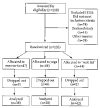Randomized, controlled, six-month trial of yoga in healthy seniors: effects on cognition and quality of life
- PMID: 16454146
- PMCID: PMC1457100
Randomized, controlled, six-month trial of yoga in healthy seniors: effects on cognition and quality of life
Abstract
Context: There are potential benefits of mind-body techniques on cognitive function because the techniques involve an active attentional or mindfulness component, but this has not been fully explored.
Objective: To determine the effect of yoga on cognitive function, fatigue, mood, and quality of life in seniors.
Design: Randomized, controlled trial comparing yoga, exercise, and wait-list control groups.
Participants: One hundred thirty-five generally healthy men and women aged 65-85 years.
Intervention: Participants were randomized to 6 months of Hatha yoga class, walking exercise class, or wait-list control. Subjects assigned to classes also were asked to practice at home.
Main outcome measures: Outcome assessments performed at baseline and after the 6-month period included a battery of cognitive measures focused on attention and alertness, the primary outcome measures being performance on the Stroop Test and a quantitative electroencephalogram (EEG) measure of alertness; SF-36 health-related quality of life; Profile of Mood States; Multi-Dimensional Fatigue Inventory; and physical measures related to the interventions.
Results: One hundred thirty-five subjects were recruited and randomized. Seventeen subjects did not finish the 6-month intervention. There were no effects from either of the active interventions on any of the cognitive and alertness outcome measures. The yoga intervention produced improvements in physical measures (eg, timed 1-legged standing, forward flexibility) as well as a number of quality-of-life measures related to sense of well-being and energy and fatigue compared to controls.
Conclusions: There were no relative improvements of cognitive function among healthy seniors in the yoga or exercise group compared to the wait-list control group. Those in the yoga group showed significant improvement in quality-of-life and physical measures compared to exercise and wait-list control groups.
Figures
References
-
- Saper RB, Eisenberg DM, Davis RB, Culpepper L, Phillips RS. Prevalence and patterns of adult yoga use in the United States: results of a national survey. Altern Ther Health Med. 2004;10:44–49. - PubMed
-
- Barnes PM, Powell-Griner E, McFann K, Nahin RL. Complementary and alternative medicine use among adults: United States, 2002. CDC Ad Data. 2004;(343) May 27, 2004:1–19. - PubMed
-
- Berger BG, Owen DR. Mood alteration with yoga and swimming: aerobic exercise may not be necessary. Percept Mot Skills. 1992;75(3 Pt 2):1331–1343. - PubMed
-
- Berger BG, Owen DR. Stress reduction and mood enhancement in four exercise modes: swimming, body conditioning, Hatha yoga, and fencing. Res Q Exerc Sport. 1988;59(2):148–159.
-
- Feuerstein G. Traditional definitions of yoga. Yoga Research and Education Center website. Available at: http://www.yrec.info/contentid-l7.html Accessed November 29, 2005.
Publication types
MeSH terms
Grants and funding
LinkOut - more resources
Full Text Sources
Medical

